最新资讯
您的位置:
首页 >>
最新资讯
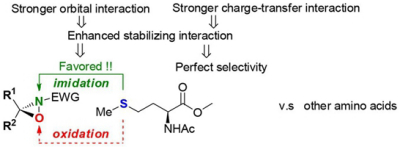
32. Mechanism and Origin of Chemical Selectivity in Oxaziridine-Based Methionine Modification: A Computational Study
Oxaziridine-based redox sulfur imidation provides a breakthrough strategy for selective modification at methionine in proteins. The chemoselectivity of imidization (N-transfer) over oxidation (O-transfer) of the thioether functionality of methionine, and the modification selectivity of methionine over other amino acids, are the key features of this strategy. To elucidate the detailed reaction mechanism and the origin of the reported chemoselectivity, a theoretical investigation on the oxaziridine-based methionine modification reaction is reported. It is found that both the N-transfer and O-transfer pathways occur in a concerted mechanism. Distortion/interaction−activation strain model analysis indicates that the N-transfer chemoselectivity is mainly controlled by the interaction energy. Orbital and charge analysis further supports that the interaction energy resulting from the orbital interaction favors the N-transfer pathway at the early stage of the reaction. The calculated reactivit
2024-04-23
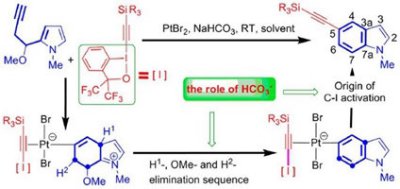
31. Mechanistic Study on Platinum-Catalyzed Domino Reaction of Benziodoxole and Pyrrole Homopropargylic Ethers for Indole Synthesis
Benzene ring functionalization provides useful alternatives to access indole derivatives and has received much attention in recent years. In this work, the mechanism of Pt(II)-catalyzed cyclization/alkynylation of benziodoxole with pyrrole homopropargylic ethers to generate C5-alkenylated indole derivatives has been studied with the aid of density functional theory (DFT) calculations. We found that fivemembered-ring cyclization/six-membered-ring cyclization is competitive in the formation of an indole skeleton. The following aromatization stage prefers the reaction sequence bicarbonate-assisted deprotonation at the C3a position, H2CO3-promoted methoxy elimination at the C7 position, and bicarbonate-assisted deprotonation at the C6 position. In the last alkynylation stage, the oxidative substitution mechanism assisted by H2CO3 is found to be favored over the previously proposed 1,2-iodo shift and oxidative addition. The overall ratedetermining step is oxidative substitution. Additionall
2024-04-23
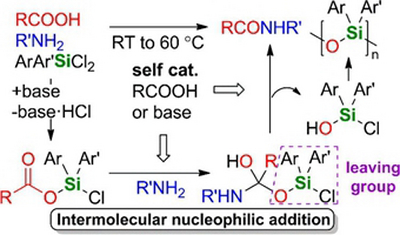
30. Mechanism of Amide Bond Formation from Carboxylic Acids and Amines Promoted by 9-Silafluorenyl Dichloride Derivatives
The couplings of carboxylic acids and amines promoted by dichlorosilane derivatives provide a promising tool for amide synthesis and peptide coupling, in which an unprecedented mechanism was proposed for the amide bond formation process. To investigate this mechanistic proposal and enrich the understanding of this novel reaction, a theoretical study was conducted herein. The formation and interconversion of silylamine and silyl ester intermediates were calculated to be kinetically feasible under the experiment conditions. However, the subsequent amidation via direct elimination on the AcO-Si(L)(L′)-NHMe intermediate was found to involve a high energy barrier due to the formation of an unstable silanone. By contrast, the in situ generated salts can promote the amidation process by generating a silanol as the temporary product. Similarly, the anhydride formation mechanism can proceed via direct elimination or salt-assisted elimination on the AcO-Si(L)(L′)-OAc intermediate but is less fav
2024-04-23
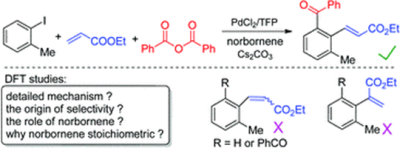
29. Mechanism of Pd-catalyzed acylation/alkenylation of aryl iodide: a DFT study
The Pd-catalyzed cross-coupling of aryl iodide, benzoic anhydride and ethyl acrylate provided a useful alternative to synthesize alkenylated aryl ketones with good selectivity and functional-group tolerance. In this manuscript, density functional theory (DFT) calculations were performed to address the detailed reaction mechanism. Computational results support the experimentally proposed Pd(0)–Pd(II)–Pd(IV) catalytic cycle and further clarify that the rate-determining step is the oxidative addition of benzoic anhydride, the regioselectivity-determining step is the migratory insertion of ethyl acrylate and the following β-H elimination determines the stereoselectivity. The regioselectivity can be attributed to the steric and electronic effect of ethyl acrylate and the stereoselectivity can be explained by the steric repulsion between the toluene moiety and the CO2Et moiety. Furthermore, we found that norbornene not only acts as the removable scaffold in Catellani–Lautens type reactions,
2024-04-23
Publications

服务热线
010-8888888
最新资讯
最新资讯
您的位置:
首页 >>
最新资讯

96. Non-C1 Synthon Role of CO2: Promoting Divergent Electrochemical Defluorination
Here, an unpresented non-C1 synthon function of CO2 is reported to facilitate electrochemical defluorination. The introduction of CO2 modulates the electron distribution of the radical anion intermediate generated through one-electron reduction, thereby weakening the reduction potential and facilitating reduction and defluorination. CO2 is released subsequently via spontaneous decarboxylation to complete its promotion role. The presented results shed light on a distinctive utilization of CO2, which may stimulate interest in developing non-C1 synthon functions of CO2.
2025-06-13

95. Transition-Metal-Free Mild and Regioselective Alkylation of Quinoline N-Oxides with Benzylboronates
A KOtBu-mediated C2-benzylation of quinoline N-oxides with benzylboronates under mild reaction conditions has been developed. The reaction shows broad scope for both of the quinoline N-oxides and benzylboronates, especially, secondary and tertiary benzylboronates are also compatible with this reaction. DFT calculations indicate that the reaction is promoted by the nucleophilic addition of KOtBu to boronate rather than the deprotonation of benzylic C−H bond with KOtBu.
2025-06-13
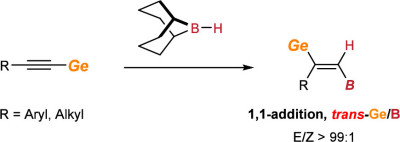
94. trans-Ge/B 1,1-Hydroboration of Alkynylgermanes with 9‑BBN
A 1,1-hydroboration of alkynylgermanes with unique transGe/B stereochemistry under transition-metal-free conditions is reported. Mechanistic studies suggest that a pathway involving α boration followed by a stepwise 1,2-Ge/H shift on the intermediate structurally lies between an alkyne−Ge+ π complex and a typical vinyl cation. The resulting Ge/B bimetallic modules, along with a Ge*/Ge/B trimetallic variant, can be conveniently transformed into trisubstituted olefins through iterative divergent cross-coupling. This work demonstrates that incorporating metalloids into classical organic reactions may offer unconventional chemical selectivity and efficient synthetic applications.
2025-05-25

93. Nickel/Photoredox Catalyzed Aryl-Alkyl Cross-Coupling with Alkyl Boronic Esters as Radical Precursors
Nickel/photoredox dual catalyzed cross-coupling of aryl halides with alkylboron compounds is one of the effective methodologies for the construction of C(sp2) C(sp3) bonds. Although elegant results have been achieved by using alkyl trifluoroborates as alkyl radical precursors, the generation of alkyl radicals from readily available alkyl boronic esters is still limited due to their high oxidation potential. We disclosed here that activation of alkyl boronic esters by MeOLi is highly efficient for the generation of alkyl radicals under photocatalysis conditions. The reaction featured with a wide substrate scope, high functional group tolerance, and late-stage modification of bioactive substances. In addition, the method was also successfully extended to alkyl boronic acids. Experimental and computational mechanistic studies indicated that the crosscoupling likely proceeds via a Ni(I)-catalyzed pathway.
2024-12-23
资讯中心
服务热线
010-8888888
最新资讯
最新资讯
您的位置:
首页 >>
最新资讯

96. Non-C1 Synthon Role of CO2: Promoting Divergent Electrochemical Defluorination
Here, an unpresented non-C1 synthon function of CO2 is reported to facilitate electrochemical defluorination. The introduction of CO2 modulates the electron distribution of the radical anion intermediate generated through one-electron reduction, thereby weakening the reduction potential and facilitating reduction and defluorination. CO2 is released subsequently via spontaneous decarboxylation to complete its promotion role. The presented results shed light on a distinctive utilization of CO2, which may stimulate interest in developing non-C1 synthon functions of CO2.
2025-06-13

95. Transition-Metal-Free Mild and Regioselective Alkylation of Quinoline N-Oxides with Benzylboronates
A KOtBu-mediated C2-benzylation of quinoline N-oxides with benzylboronates under mild reaction conditions has been developed. The reaction shows broad scope for both of the quinoline N-oxides and benzylboronates, especially, secondary and tertiary benzylboronates are also compatible with this reaction. DFT calculations indicate that the reaction is promoted by the nucleophilic addition of KOtBu to boronate rather than the deprotonation of benzylic C−H bond with KOtBu.
2025-06-13

94. trans-Ge/B 1,1-Hydroboration of Alkynylgermanes with 9‑BBN
A 1,1-hydroboration of alkynylgermanes with unique transGe/B stereochemistry under transition-metal-free conditions is reported. Mechanistic studies suggest that a pathway involving α boration followed by a stepwise 1,2-Ge/H shift on the intermediate structurally lies between an alkyne−Ge+ π complex and a typical vinyl cation. The resulting Ge/B bimetallic modules, along with a Ge*/Ge/B trimetallic variant, can be conveniently transformed into trisubstituted olefins through iterative divergent cross-coupling. This work demonstrates that incorporating metalloids into classical organic reactions may offer unconventional chemical selectivity and efficient synthetic applications.
2025-05-25

93. Nickel/Photoredox Catalyzed Aryl-Alkyl Cross-Coupling with Alkyl Boronic Esters as Radical Precursors
Nickel/photoredox dual catalyzed cross-coupling of aryl halides with alkylboron compounds is one of the effective methodologies for the construction of C(sp2) C(sp3) bonds. Although elegant results have been achieved by using alkyl trifluoroborates as alkyl radical precursors, the generation of alkyl radicals from readily available alkyl boronic esters is still limited due to their high oxidation potential. We disclosed here that activation of alkyl boronic esters by MeOLi is highly efficient for the generation of alkyl radicals under photocatalysis conditions. The reaction featured with a wide substrate scope, high functional group tolerance, and late-stage modification of bioactive substances. In addition, the method was also successfully extended to alkyl boronic acids. Experimental and computational mechanistic studies indicated that the crosscoupling likely proceeds via a Ni(I)-catalyzed pathway.
2024-12-23
资讯中心
服务热线
010-8888888
最新资讯
当前为空白尾部,您可以切换设计使用内置页尾版块或者拖拽元素到此区域自由设计